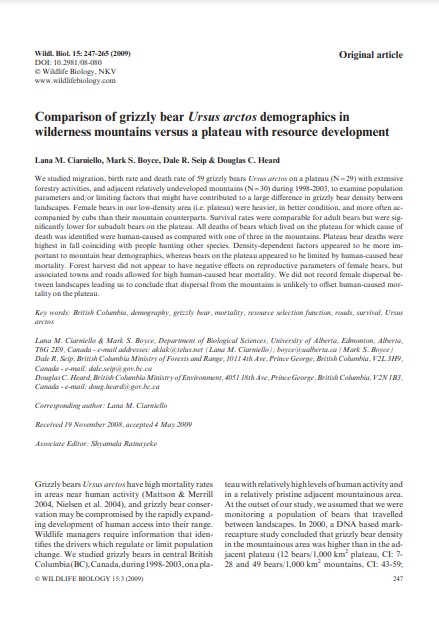Comparison of grizzly bear Ursus arctos demographics in wilderness mountains versus a plateau with resource development
Bosque Modelo:
McGregor
Temática:
Conservación
Tipo de documento:
Artículo científico
Resumen
We studied migration, birth rate and death rate of 59 grizzly bears Ursus arctos on a plateau (N=29) with extensive forestry activities, and adjacent relatively undeveloped mountains (N=30) during 1998-2003, to examine population parameters and/or limiting factors that might have contributed to a large difference in grizzly bear density between landscapes. Female bears in our low-density area (i.e. plateau) were heavier, in better condition, and more often accompanied by cubs than their mountain counterparts. Survival rates were comparable for adult bears but were significantly lower for subadult bears on the plateau. All deaths of bears which lived on the plateau for which cause of death was identified were human-caused as compared with one of three in the mountains. Plateau bear deaths were highest in fall coinciding with people hunting other species. Density-dependent factors appeared to be more important to mountain bear demographics, whereas bears on the plateau appeared to be limited by human-caused bear mortality. Forest harvest did not appear to have negative effects on reproductive parameters of female bears, but associated towns and roads allowed for high human-caused bear mortality. We did not record female dispersal between landscapes leading us to conclude that dispersal from the mountains is unlikely to offset human-caused mortality on the plateau.
Información Bibliográfica
Autor:
Ciarniello, Lana M.; Boyce, Mark S.; Seip, Dale R.; Heard, Douglas C.
Revista:
Wildlife Biology
Año:
2009
N°:
3
País :
Canadá
Páginas:
247 - 265
Volumen:
15
Idioma:
Ingles
Palabras claves
British Columbia, demography, grizzly bear, mortality, resource selection function, roads, survival, Ursus arctos





